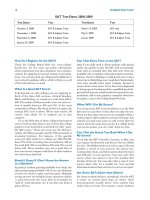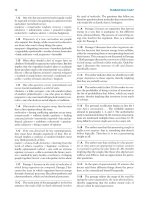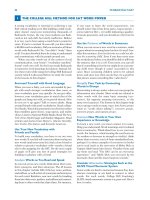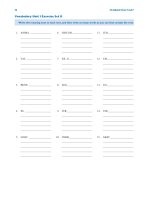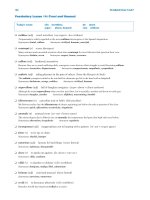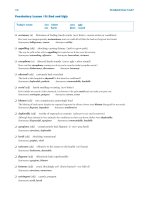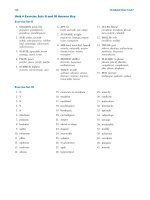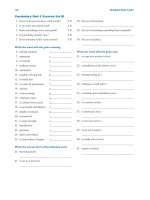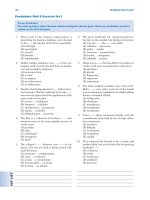Sat - MC Grawhill part 37 ppt
Bạn đang xem bản rút gọn của tài liệu. Xem và tải ngay bản đầy đủ của tài liệu tại đây (217.71 KB, 10 trang )
350 MCGRAW-HILL’S SAT
Using Venn Diagrams to Keep
Track of Sets
Some counting problems involve “overlapping
sets,” that is, sets that contain elements that
also belong in other sets. In these situations,
Venn diagrams are very helpful for keeping
track of things.
Example:
A class of 29 students sponsored two field trips: one
to a zoo and one to a museum. Every student at-
tended at least one of the field trips, and 10 stu-
dents attended both. If twice as many students
went to the zoo as went to the museum, how many
students went to the zoo?
Set up a Venn diagram of the situation. We repre-
sent the two sets—those who went to the museum
and those who went to the zoo—as two overlapping
circles, because some students went to both. Notice
that there are three regions to consider. We know that
ten students are in the overlapping region, but we
don’t know how many are
in the other two regions,
so let’s use algebra. Let’s
say that x students are in
the first region, represent-
ing those who went to the
museum but not to the
zoo. This means that x +
10 students must have
gone to the museum altogether. Since twice as many
students went to the zoo, the total number in the zoo
circle must be 2(x + 10) = 2x + 20. Since 10 of these are
already accounted for in the overlapping region, there
must be 2x + 20 − 10 = 2x + 10 in the third region. So
now the diagram should look like this:
The total number of students is 29, so
(x) + (10) + (2x + 10) = 29
Simplify: 3x + 20 = 29
Solve: x = 3
So the number of students who went to the zoo is
2(3) + 20 = 26.
The Fundamental Counting Principle
Some SAT questions ask you to count things. Some-
times it’s easy enough to just write out the things in a
list and count them by hand. Other times, though,
there will be too many, and it will help to use the Fun-
damental Counting Principle.
Lesson 5: Counting Problems
To use the Fundamental Counting Principle
(FCP), you have to think of the things you’re
counting as coming from a sequence of
choices. The Fundamental Counting Principle
says that the number of ways an event can hap-
pen is equal to the product of the choices that
must be made to “build” the event.
Example:
How many ways can five people be arranged in
a line?
You might consider calling the five people A, B, C, D,
and E, and listing the number of arrangements. After a
while, though, you’ll see that this is going to take a lot
of time, because there are a lot of possibilities. (Not to
mention that it’s really easy to miss some of them.) In-
stead, think of “building” the line with a sequence of
choices: first pick the first person, then pick the second
person, etc. There are five choices to make, so we’ll
have to multiply five numbers. Clearly, there are
five people to choose from for the first person in line.
Once you do this, though, there are only four people left
for the second spot, then three for the third spot, etc. By
the Fundamental Counting Principle, then, the number
of possible arrangements is 5 × 4 × 3 × 2 × 1 = 120.
Example:
How many odd integers greater than 500 and less
than 1,000 have an even digit in the tens place?
This seems a lot harder than it is. Again, think of
“building” the numbers in question. All integers
between 500 and 1,000 have three digits, so building
the number involves choosing three digits, so we will
multiply three numbers to get our answer. If each
number is between 500 and 1,000, then there are only
five choices for the first digit: 5, 6, 7, 8, or 9. If the tens
digit must be even, we have five choices again: 2, 4, 6,
8, or 0. If the entire number is odd, then we have five
choices for the last digit as well: 1, 3, 5, 7, or 9.
Therefore, the total number of such integers is
5 × 5 × 5 = 125.
To the
Museum
To the
Zoo
Museum
(but not
Zoo)
Zoo
(but not
Museum)
Both
10x 2x + 10
MZ
CHAPTER 9 / SPECIAL MATH PROBLEMS 351
1. What is the fundamental counting principle?
2. How many different four-letter arrangements of the letters LMNO can be made if no letter can be repeated?
Answer this first by listing all of the possible arrangements, then by using the Fundamental Counting Prin-
ciple, and check that the two answers agree.
3. If the first digit of a 3-digit area code cannot be 0 and the second digit is either 0 or 1, then how many dif-
ferent area codes are possible?
4. A baseball team has six players, each of whom can play in any of the three outfield positions: left field, cen-
ter field, and right field. How many possible different arrangements of these players can the team place in
the outfield? (This one is a bit harder to do by listing!)
5. Among a set of 40 sophomores, 20 students take French and 27 students take Spanish. If all of the students
take either French or Spanish, how many students take both French and Spanish?
6. A box contains buttons, each of which is either blue or green and has either two or four holes. If there are
four times as many blue buttons as green buttons and six times as many four-holed buttons as two-holed
buttons, what is the least number of buttons that could be in the box?
Concept Review 5: Counting Problems
352 MCGRAW-HILL’S SAT
SAT Practice 5: Counting Problems
1. A pizzeria offers three different sizes of pizza,
two different kinds of crust, and eight different
choices for toppings. How many different one-
topping pizzas are there to choose from?
(A) 13 (B) 16 (C) 24
(D) 48 (E) 60
0, 2, 4, 6, 8
2. How many different integers between 30 and
70 contain only digits from the list above?
(A) 7 (B) 10 (C) 15
(D) 20 (E) 25
3. In how many ways can you arrange four different
paintings in a line on a wall?
(A) 12 (B) 24 (C) 36
(D) 48 (E) 64
4. At Lincoln County High School, 36 students are
taking either calculus or physics or both, and 10
students are taking both calculus and physics.
If there are 31 students in the calculus class,
how many students are there in the physics
class?
(A) 5 (B) 8 (C) 11
(D) 15 (E) 21
5. Dave’s stickball team has six players. How
many different six-player batting lineups can
they make if Dave must bat second and either
Zack or Paul must bat first?
(A) 48 (B) 96 (C) 192
(D) 256 (E) 720
6. Maria gave David x cards, gave Tina two more
cards than she gave David, and gave Samuel five
fewer cards than she gave Tina. In terms of x,
how many cards did Maria give Tina, David,
and Samuel all together?
(A) 3x + 9 (B) 3x − 1
(C) 3x − 3 (D) x − 3
(E) x − 1
7. From a collection of six paintings, four are to be
chosen to hang on a wall. How many different
arrangements are possible if every painting is
different?
(A) 24 (B) 120 (C) 360
(D) 720 (E) 1,296
8. Every marble in a jar has either a dot, a stripe,
or both. The ratio of striped marbles to non-
striped marbles is 3:1, and the ratio of dotted
marbles to nondotted marbles is 2:3. If six mar-
bles have both a dot and a stripe, how many
marbles are there all together?
(A) 16 (B) 18 (C) 20
(D) 36 (E) 40
9. An ant must walk from one vertex of a cube to
the “opposite” vertex (that is, the vertex that is
farthest from the starting vertex) and back
again to its starting position.
It may only walk along the
edges of the cube. For the
entire trip, its path must tra-
verse exactly six edges, and
it may travel on the same
edge twice. How many dif-
ferent six-edge paths can the
ant choose from?
1
2
3
4
5
7
8
9
6
1
0
2
3
4
5
7
8
9
6
1
0
2
3
4
5
7
8
9
6
1
0
2
3
4
5
7
8
9
6
SAT Practice 5
1. D Use the FCP: 3 × 2 × 8 = 48.
2. B “Build” the number: If it’s between 30 and 70,
it must be a two-digit number that begins with 4
or 6. That’s two choices. The second digit can be
anything in the list, so that’s 5 choices. 2 × 5 = 10
3. B Since there are four spaces, there are four deci-
sions to make, so four numbers to multiply. You can
choose from four paintings for the first spot, then three
paintings for the second spot, etc. 4 × 3 × 2 × 1 = 24
4. D If there are 31 students in calculus but 10 of
these are also taking physics, then 31 − 10 = 21 stu-
dents are taking only calculus. If there are 36 stu-
dents taking either physics or calculus, but only 31
are taking calculus, then 36 − 31 = 5 students are
taking only physics. Therefore, the Venn diagram
should look like this:
As you can see, 5 + 10 = 15
students are taking physics.
5. A “Build” the lineup. You have six spots to fill,
and thus six decisions to make and six numbers to
multiply. You only have two choices for the first
spot (Zack or Paul) and one choice for the second
spot (Dave), then you have four players left to fill
the other slots, so you have four choices for the
third spot, then three for the fourth spot, etc.
2 × 1 × 4 × 3 × 2 × 1 = 48
6. B David gets x cards. Tina gets two more cards
than David, which is x + 2. Samuel gets five fewer
cards than Tina, which is x + 2 − 5 = x − 3. So all
together, x + x + 2 + x − 3 = 3x − 1.
7. C You have six choices for the first spot, then five
for the second, then four for the third and three for
the fourth. 6 × 5 × 4 × 3 = 360
8. E Set up the Venn diagram: Since
the ratio of striped marbles
to nonstriped marbles is 3:1, x + 6 =
3y, and since the ratio of dotted
marbles to nondotted marbles is 2:3, y + 6 = 2/3x and
therefore y = 2/3x − 6. Substituting, we get x +
6 = 3(2/3x − 6) or x + 6 = 2x − 18, so x = 24. Plug
this back in to get y = 2/3(24) − 6 = 10. Total =
24 + 6 + 10 = 40.
9. 36 Draw the cube. To get from any vertex to its
opposite vertex, the ant has 3 × 2 × 1 possible paths.
To see why, trace a path and notice it has three
choices for the first edge, then two for the second,
then only one option for the third. Since it must
return to the opposite vertex, it has 3 × 2 × 1 differ-
ent paths it can take back. 3 × 2 × 1 × 3 × 2 × 1 = 36
CHAPTER 9 / SPECIAL MATH PROBLEMS 353
Concept Review 5
1. The number of ways an event can happen is equal
to the product of the choices that must be made
to “build” the event.
2. Try listing all the “words” that start with L, then
all that start with M, and so on:
LMNO MLNO NLMO OLMN
LMON MLON NLOM OLNM
LNMO MNLO NMLO OMLN
LNOM MNOL NMOL OMNL
LOMN MOLN NOLM ONML
LONM MONL NOML ONLM
Whew! 24 in total. Annoying, but not impossible.
Using the FCP makes it a lot easier: 4 × 3 × 2 × 1 =
24. That’s it!
3. There are too many possibilities to list, but the
FCP makes it easy: We have 9 choices for the first
digit, 2 choices for the second digit, and 10
choices for the last digit, and 9 × 2 × 10 = 180.
4. “Build” the outfield from left to right. You have
6 players to choose from for left field, but then just
5 for center field and 4 for right field. 6 × 5 ×4 =120.
5. Since 20 + 27 − 40 = 7, there must be 7 students
who take both. This Venn diagram shows how it
works out:
6. This one’s tough. Say there are g green buttons. If
there are four times as many blue buttons as
green buttons, then there are 4g blue buttons, so
g + 4g = 5g buttons in total. So the total number of
buttons must be a multiple of 5. Similarly, if there
are n two-holed buttons, there must be 6n four-
holed buttons, so the total number of buttons is n
+ 6n = 7n, so the total number of buttons is also a
multiple of 7. The least common multiple of 5 and
7 is 35, so there are 35 buttons: 5 two-holed and
30 four-holed, and 7 green and 28 blue.
713 20
FS
Answer Key 5: Counting Problems
10521
PC
6xy
DS
354 MCGRAW-HILL’S SAT
Probability Geometrical Probability
Lesson 6: Probability Problems
A probability is a number between 0 and 1 that
represents the likelihood of an event. An event
with a probability of 0 is impossible, and an
event with a probability of 1 is certain. Most
probabilities, of course, are somewhere in be-
tween 0 and 1. For instance, the probability of
rolling a 5 on a fair die is
1
⁄6. It’s best to think of
a probability as a part-to-whole ratio. There
are six possible outcomes when you roll a die
(the whole), but only one of them is 5 (the
part). Thus, the probability of rolling a 5 is
1
⁄6.
Example:
What is the probability of rolling a sum of 5 on
two dice?
Here is a table showing all the possible sums on a roll
of two dice:
Clearly, there are four ways of getting a sum of 5 out
of a possible 36, so the probability is
4
⁄36, or
1
⁄9.
Die 1
Die 2
1
4
2
3
6
5
123456
234567
345678
456789
5678910
67891011
7 8 9 10 11 12
An SAT question may ask you to find the prob-
ability that something hits a certain region,
like a dart hitting a dartboard. In these situa-
tions, the probability is just the ratio of the par-
ticular area to the entire area.
Example:
A landing target for skydivers consists of two con-
centric circles. The smaller circle has a radius of
3 meters, and the larger one has a radius of 6 meters.
If a skydiver hits the target, what is the probability
that she hits the smaller circle?
It might help to sketch the target:
If she hits the target, then she hits an area that is
π(6)
2
= 36π square meters in area. The smaller circle,
though, is only π(3)
2
= 9π square meters in area, so the
probability that she lands within the smaller region
should be just 9π/36π=1/4.
3
6
CHAPTER 9 / SPECIAL MATH PROBLEMS 355
1. The probability of an impossible event is __________.
2. The probability of an event that is certain is __________.
3. If a jar contains 3 red marbles, 4 white marbles, and 5 blue marbles, then what is the probability of ran-
domly choosing
a red marble? __________
a white marble? __________
a blue marble? __________
4. A jar contains 5 red marbles and 10 white marbles.
What is the probability of drawing a red marble? __________
If 3 more red marbles are added, then what is the probability of drawing a red marble? __________
5. A jar contains 24 red and blue marbles. If the probability of selecting a red marble at random is
3
⁄8, then how
many red marbles must be added so that the probability of randomly selecting a red marble becomes
1
⁄2?
6. A jar contains only black, white, and red marbles. The probability of choosing a white marble is
2
⁄3. If there
are 4 times as many red marbles as black marbles, what is the least possible number of marbles in the jar?
Concept Review 6: Probability Problems
356 MCGRAW-HILL’S SAT
SAT Practice 6: Probability Problems
1. The figure above shows a spinner in the mid-
dle of a disc divided into six equal parts, each
labeled with a number. What is the probabil-
ity that the spinner will land on a number that
is either even or greater than 5?
(A) (B) (C)
(D) (E)
2. A jar contains 10 blue marbles, 8 green marbles,
and 14 red marbles. How many green marbles
must be added so that the probability
of choosing a green marble at random is ?
(A) 16 (B) 32 (C) 40
(D) 64 (E) 72
3. A fair six-sided die has faces bearing the numbers
1, 2, 3, 4, 5, and 6. When the die is thrown, the
numbers on the five visible faces are added. What
is the probability that this sum is greater than 18?
(A) (B) (C)
(D) (E)
4. A target consists of three concentric circles,
with radii of 1 meter, 2 meters, and 3 meters.
If an arrow that hits the target hits any point
on the target with equal probability, what is
the probability that an arrow that hits the tar-
get falls in the outermost region (between the
second and third circles)?
(A) (B) (C)
(D) (E)
5
9
4
9
π
9
1
3
1
9
5
6
2
3
1
2
1
3
1
6
3
4
5
6
2
3
1
2
1
3
1
6
5. The probability of a meteor shower occurring in
the skies above a particular island on any
given night is . Independently, the proba-
bility that any given night will be cloudless is
. What is the probability that, on any given
night, there will be a meteor shower and it will
be cloudless?
(A) (B) (C)
(D) (E)
6. A basket contains red, green, and yellow balls,
all of equal size. The probability of choosing a
green ball at random is . If there are 3 times
as many red balls as yellow balls, what is the
probability of choosing a yellow ball at random?
7. A certain disease occurs in 1 person out of
every 101 people. A test for the disease is 100%
accurate for patients with the disease and 99%
accurate for patients without it. That is, it
gives a “false positive” 1% of the time even if
the person tested doesn’t have the disease. If
you take this test and it returns a positive re-
sult, what is the probability that you have the
disease?
(A) 1 (B) .99 (C) .95
(D) .50 (E) .01
1
2
3
4
5
7
8
9
6
1
0
2
3
4
5
7
8
9
6
1
0
2
3
4
5
7
8
9
6
1
0
2
3
4
5
7
8
9
6
4
7
8
25
4
25
17
200
3
100
1
50
1
4
2
25
5
9
2
8
3
6
SAT Practice 6
1. D Put an “x” through any number that is either
even or greater than 5, or both. This gives us 8, 9,
2, and 6, which is 4 out of the 6 spaces, giving a
probability of
4
⁄6, or
2
⁄3.
2. D If the probability of choosing a green marble is
to be
3
⁄4, then
3
⁄4 of the marbles should be green and
1
⁄
4
not green. There are 10 blue and 14 red, for a total
of 24 “not green” marbles, and this will not change,
since you are adding only green marbles. If this is
1
⁄4
of the total, then there must be 4(24) = 96 marbles
total after you add the extra green marbles. The jar
now contains 10 + 8 + 14 = 32 marbles, so you must
add 96 − 32 = 64 green marbles.
3. B The six sides of a die add up to 1 + 2 + 3 + 4 +
5 +6 =21. The sum of any five faces can be greater than
18 only if the “down” face is 1 or 2 (so that the sum of
the other faces is either 21 − 1 = 20 or 21 −2 = 19. This
is 2 possibilities out of 6 for a probability of
2
⁄6, or
1
⁄3.
4. E Sketch the target:
You want to know the proba-
bility of the arrow hitting the
outermost ring, which is the
ratio of the area of the ring to
the entire area of the target.
The area of the whole target is π(3)
2
= 9π. The area
of the outermost ring is 9π−π(2)
2
(subtract the area
of the middle circle from the area of the big circle)
= 9π−4π=5π. So the probability is 5π/9π=5/9.
5. A Consider a stretch of 100 consecutive nights.
If the probability of a meteor shower is
2
⁄25, then we
should expect a meteor shower on (
2
⁄25)(100) = 8 of
those nights. If only
1
⁄4 of the nights are cloudless,
though, then (
1
⁄4)(8) = 2 of the nights with a meteor
shower, on average, should be cloudless. This
gives a probability of
2
⁄100, or
1
⁄50. Mathematically,
we can just multiply the two probabilities (as long
as they are independent) to get the joint probabil-
ity: (
2
⁄25)(
1
⁄4) =
1
⁄50.
6.
3
⁄28 Call the probability of choosing a yellow ball x.
If there are three times as many red balls as yellow
balls, the probability of choosing a red ball must
be 3x. The probability of choosing a green ball is
4
⁄7. These probabilities must have a sum of 1:
x + 3x +
4
⁄7 = 1
Simplify: 4x +
4
⁄7 = 1
Subtract
4
⁄7:4x =
3
⁄7
Divide by 4: x =
3
⁄28
7. D Most people would say that this probability is
quite high, because the test is so reliable. But intu-
ition is often wrong. Imagine that you test 101 peo-
ple. Of these, on average, one will have the disease,
and 100 will not. Since the test is 100% accurate
for those who have the disease, that person will test
positive. Of the 100 who do not have the disease,
99 will test negative, but one will test positive, be-
cause of the 1% “false positive” rate. So of those
two who test positive, only one will have the dis-
ease; thus, the probability is
1
⁄2.
CHAPTER 9 / SPECIAL MATH PROBLEMS 357
Concept Review 6
1. 0
2. 1
3. red marble:
3
⁄12, or
1
⁄4
white marble:
4
⁄12, or
1
⁄3
blue marble:
5
⁄12
4. What is the probability of drawing a red marble?
5
⁄15, or
1
⁄3
If 3 more red marbles are added, what is the prob-
ability of drawing a red marble?
8
⁄18, or
4
⁄9
5. If the jar contains 24 red and blue marbles and the
probability of selecting a red marble at random is
3
⁄8,
there must be (
3
⁄8)(24) =9 red marbles, and 24 −9 =15
blue marbles. If the probability of drawing a red
marble is to be
1
⁄2, there must be as many red as blue
marbles, so you must add 15 − 9 = 6 marbles.
6. Let’s say that the probability of drawing a black
marble is x. Since there are 4 times as many red
marbles as black marbles, the probability of
drawing a red marble must be 4x. The probabil-
ity of choosing a white marble is
2
⁄3. Since we are
certain to pick one of these colors, the sum of all
of these probabilities must be 1: x + 4x +
2
/3 = 1
Simplify: 5x +
2
⁄3 = 1
Subtract
2
⁄3:5x =
1
⁄3
Divide by 5: x =
1
⁄15
Therefore,
1
⁄15 of the marbles are black,
4
⁄15 of the
marbles are red, and
2
⁄3 of the marbles are white.
The least common denominator of these fractions
is 15, which means that 15 is the least possible
number of marbles. In that case, there are 1 black
marble, 4 red marbles, and 10 white marbles.
Answer Key 6: Probability Problems
1
2
3
CHAPTER 10
ESSENTIAL GEOMETRY
SKILLS
1. Lines and Angles
2. Triangles
3. The Pythagorean Theorem
4. Coordinate Geometry
5. Areas and Perimeters
6. Similar Figures
7. Volumes and 3-D Geometry
8. Circles
358
✓
Copyright © 2008 by The McGraw-Hill Companies, Inc. Click here for terms of use.
When Two Lines Cross
When two lines cross, four angles are formed.
“Vertical” angles are equal, and look like this:
Don’t be fooled by diagrams that look like ver-
tical angles, but aren’t. Vertical angles are
formed by two and only two crossed lines.
When two pairs of vertical angles are formed,
four pairs of adjacent angles (side-by-side) are
also formed. Adjacent angles add up to 180°:
When a Line Crosses Parallel Lines
Imagine taking two crossed lines, making a “copy” of
them, and sliding the copy down one of the lines so
that together they look like this:
This produces a pair of parallel lines crossed by a
third line.
"slide"
v
ertical not vertical
vertical
angles
CHAPTER 10 / ESSENTIAL GEOMETRY SKILLS 359
When two parallel lines are crossed by another
line, all acute angles are equal, and all obtuse
angles are equal. Also, every acute angle is sup-
plementary to every obtuse angle (that is, they
add upto 180Њ).
To show that two lines are parallel, use the arrow
marks “>” like those in the figure in the previous
column. To show that two angles are equal, use
the arc marks “)” like those in the figure in the
previous column.
Don’t be fooled by diagrams that only look as
if they have two parallel lines crossed by an-
other line. Don’t assume that two lines are par-
allel just because they look parallel. It must be
given that they are parallel.
To help yourself to see the relationships be-
tween angles in parallel line systems, you
might try looking for these special “letters”:
Angles that make Z’s are equal:
Angles that make C’s or U’s are supplementary
(they have a sum of 180°):
Angles that make F’s are equal:
x°
x°
y°
y°
b°
a°
a + b = 180°
c°
d°
c + d = 180°
a°
a°
Lesson 1: Lines and Angles
adjacent angles
